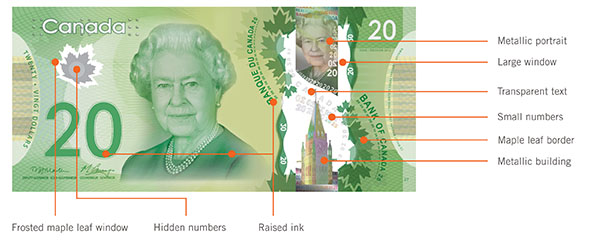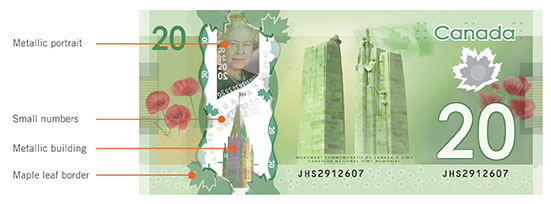Canadian retailers need to prepare for new bank notes
By CO Staff @canadaone | June 19, 2012
As the Bank of Canada brings new polymer notes into circulation, Canadian retailers need to make sure that their equipment and staff are prepared to handle the new bills.
The $50 and $100 notes are already in circulation and the $20 note will be released this fall. Retailers should expect to see the $10 and $5 notes in circulation by the end of 2013.
Equipment like cash counters, ABMs, self-serve checkouts or vending machines may need to be upgraded or replaced to process the new notes and staff will need to be trained to recognize the enhanced security features on the new bills.
Security features on the new $20 polymer bank note (front)

Security features on the new $20 polymer bank note (back)

Here is an overview of nine things the Bank of Canada recommends checking to spot counterfeit notes.
-
Feel: the new notes have raised ink on the large number, shoulders of the portrait and the words "Bank of Canada" and "Banque du Canada."
-
Window: on the new notes you will see a window with a metallic portrait and building. This window should be partially transparent.
-
Metallic portrait: the portrait in the window should match the larger portrait on the bank note.
-
Metallic building: if you tilt the note, you should see a sharp colour change in the metallic building shown in the window.
-
Matching numbers: the small numbers in the window (which will be shown normally and in reverse) should match the denomination of the note.
-
Transparent "Canada": the window has the word Canada which is transparent and should feel slightly raised.
-
Maple leaves: the window has a border of maple leaves, some of which should cross into the window.
-
Frosted maple leaf: when you look at the frosted maple leaf window, its outline should be transparent.
-
Hidden numbers: on the flip side of the note, you should see hidden numbers in the frosted maple leaf.
To facilitate the phasing out of older paper notes, the Bank of Canada is encouraging businesses to separate polymer and paper notes in the till and bank deposit.
If you enjoyed this article, be sure to visit CanadaOne's article knowledge base for more informative articles.








